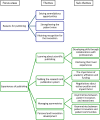Why publish? An interview study exploring patient innovators' reasons for and experiences of scientific publishing
- PMID: 38845024
- PMCID: PMC11157806
- DOI: 10.1186/s40900-024-00589-9
Why publish? An interview study exploring patient innovators' reasons for and experiences of scientific publishing
Abstract
Background: Scientific publications featuring patient-driven innovations (i.e., innovations that are developed and driven by patients or informal caregivers) are increasing. By understanding patient innovators' experiences of research publication, the scientific community may be better prepared to support or partner with patient innovators. Thus, the aim of this study was to explore patient innovators' reasons for and experiences of authoring scientific publications about their innovations.
Methods: Qualitative semi-structured interviews were conducted with 15 international patient innovators from three continents who had published in scientific journals. Participants were identified through a scoping review on patient-driven innovations and snowball sampling. Interviews were conducted from June to October 2022 and the data was analyzed using the Framework Method.
Findings: Participants' reasons for publishing in scientific journals were to strengthen the roles and voices of patients and informal caregivers, and to get recognition for their innovations. Some published as a response to serendipitous opportunities. Several positive experiences were reported: collaborations defined by transparency, mutual respect, and meaningful participation; learning and competence development; and gained confidence regarding the value of lived experiences in research. Participants also reported negative experiences, such as cultural barriers manifested as conservatism in academia and power imbalances between participants and researchers, and structural barriers regarding academic affiliations and research funding.
Conclusions: Despite progress in increasing patient and public involvement in research and publication, our study found that patient innovators still experience barriers. This suggests that continued efforts are needed to facilitate contributions from patient innovators and other public actors to the production of relevant and meaningful research.
Keywords: Patient agency; Patient and public involvement; Patient author; Patient-driven innovations.
Plain language summary
Rapid technological advances over the past decades have resulted in many health innovations that enable persons living with chronic conditions to better manage their health conditions in self-care. Similarly, caregivers can provide more advanced informal care. Do-it-yourself health innovations, such as automatic insulin dosing for diabetes patients, have been developed by patients and informal caregivers whom we in this study defined as patient innovators. There is an increasing trend of research focusing on such patient-driven innovations. However, we know little about the driving forces of patient innovators to contribute to scientific publications about their innovations. Therefore, the aim of this study was to explore patient innovators’ reasons for publishing and their experiences thereof. We interviewed 15 international patient innovators who had experience of scientific publishing. Their main driving forces were to make patients’ voices heard and receive recognition for their innovations, which could facilitate spread to other patients. The patient innovators in our study had positive experiences and meaningful collaborations with researchers that contributed to developing their scientific skills. However, they also faced challenges, such as managing their health and professional occupations besides research, being questioned by peer reviewers, and difficulties tackling the research and publication system without academic affiliation or funding. Our findings suggest that despite strong driving forces and positive experiences of scientific publishing, patient innovators face barriers that need to be addressed to facilitate the publication process for contributors without academic experience.
© 2024. The Author(s).
Conflict of interest statement
The authors declare no competing interests.
References
-
- Duncan TS. Paving the way: the second generation of e-patients, their experiences, actions and driving forces. Solna: Karolinska Institutet, Dept of Learning, Informatics, Management and Ethics; 2022.
-
- Patient Innovation. Patient innovation - sharing solutions, improving life. 2022. Available from: https://patient-innovation.com/.
Grants and funding
- 2018-01472/Swedish Research Council for Health, Working Life and Welfare (FORTE)
- 2018-01472/Swedish Research Council for Health, Working Life and Welfare (FORTE)
- 2018-01472/Swedish Research Council for Health, Working Life and Welfare (FORTE)
- 2018-01472/Swedish Research Council for Health, Working Life and Welfare (FORTE)
- 2018-01472/Swedish Research Council for Health, Working Life and Welfare (FORTE)
LinkOut - more resources
Full Text Sources
Miscellaneous


